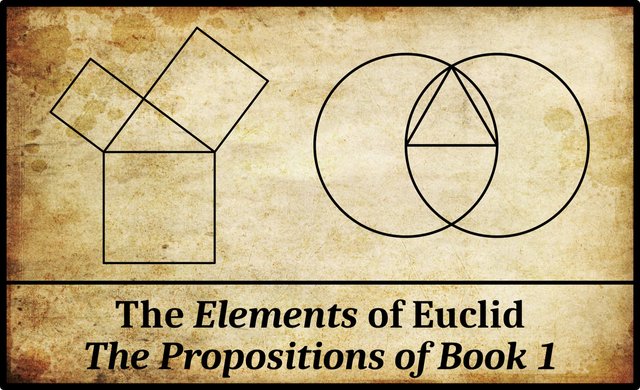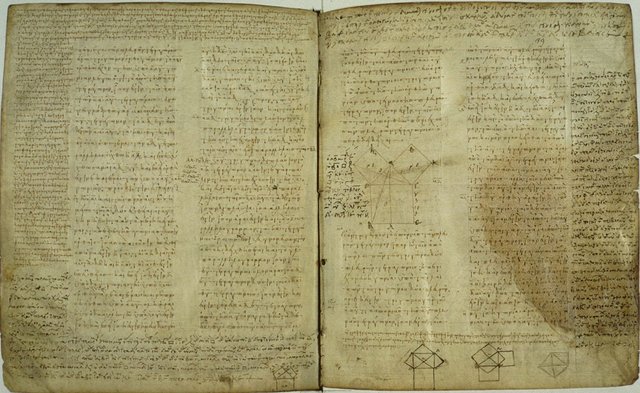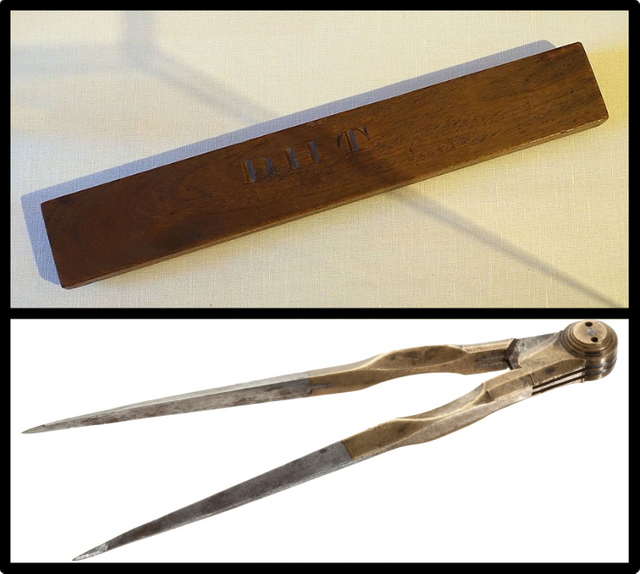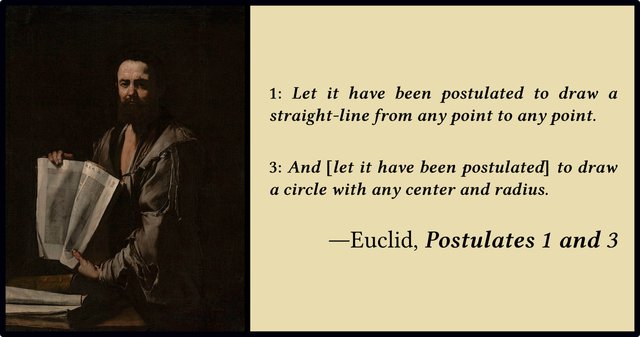
Book 1 of Euclid’s Elements contains 48 propositions. These can be divided into two broad categories:
Theorems
Constructions
A theorem is a proposition that proves some geometric property or fact. For example, Proposition 1:47, the Pythagorean Theorem, proves that in any right triangle the square on the hypotenuse is equal to the sum of the squares on the other two sides.
A construction is a proposition that proves that some geometric object actually exists by constructing it and then showing that the constructed object has the properties that satisfy the definition of the required geometric object. For example, Proposition 1:1 proves that equilateral triangles exist.
Other constructions prove that certain actions are geometrically possible or valid in Euclidean geometry. For example, Proposition 1:9 demonstrates how to bisect an angle.
In his Commentary on the First Book of Euclid’s Elements Proclus refers to these two categories as Theorems and Problems:
Again the propositions that follow from the first principles he [Euclid] divides into problems and theorems, the former including the construction of figures, the division of them into sections, subtractions from and additions to them, and in general the characters that result from such procedures, and the latter concerned with demonstrating inherent properties belonging to each figure ... Some of the ancients, however, such as the followers of Speusippus and Amphinomus, insisted on calling all propositions “theorems,” considering “theorems” to be a more appropriate designation than “problems” for the objects of the theoretical sciences, especially since these sciences deal with eternal things. ―Morrow 63–64
Speusippus was Plato’s nephew and his successor as Scholarch of the Academy (347–339). Amphinomus is thought to have been a contemporary of Speusippus, but he is otherwise unknown.
Only fourteen of the forty-eight propositions in Book 1 of the Elements are constructions. In David Joyce’s online edition of the Elements, these are displayed in red.

Many of the propositions in Book 1 of the Elements will be familiar to anyone who has studied geometry in high-school:
The angles at the base of an isosceles triangle are equal in measure (Proposition 1:5).
The sum of the angles of a triangle is equal to two right angles (Proposition 1:32).
The Side-Angle-Side Theorem (Proposition 1:4).
The exterior angle of a triangle is equal to the sum of the two interior and opposite angles (Proposition 1:32).
The propositions of Book 1 deal with the plane geometry of triangles, parallelograms and straight lines. Beginning with an elementary construction, Euclid proceeds in a logical fashion, using simpler theorems to prove more advanced ones. The book culminates with what is undoubtedly the most famous theorem in all mathematics, the Pythagorean Theorem (Proposition 1:47), and its converse (Proposition 1:48).
Aristotle on Definitions
In his Posterior Analytics 92 b 12 ff Aristotle discusses an important distinction between definition and existence, which is very relevant to Euclid’s geometry. As Thomas Heath points out:
Let us now first be clear as to what a definition does not do. There is nothing in connexion with definitions which Aristotle takes more pains to emphasise than that a definition asserts nothing as to the existence or non-existence of the thing defined. It is an answer to the question what a thing is (τί ἐστι), and does not say that it is (ὅτι ἔστι). The existence of the various things defined has to be proved, except in the case of a few primary things in each science, the existence of which is indemonstrable and must be assumed among the first principles of each science; e.g. points and lines in geometry must be assumed to exist, but the existence of everything else must be proved. ―Heath 143
Euclid does not explicitly assert that points and lines exist, but his First Postulate implies that they do:
- Let it have been postulated to draw a straight-line from any point to any point. (Fitzpatrick 7)
He also assumes the existence of circles, as this is implied by Postulate 3:
- And to draw a circle with any center and radius. (Fitzpatrick 7)
Euclid has indeed no separate assumption affirming the existence of points such as we find nowadays in text-books like those of Veronese, [Giuseppe] Ingrami, Enriques, “there exist distinct points” or “there exist an infinite number of points.” But, as regards the only lines dealt with in the Elements, straight lines and circles, existence is asserted in Postulates 1 and 3 respectively. ―Heath 195
It need hardly be added that, speaking generally, Euclid’s definitions, and his use of them, agree with the doctrine of Aristotle that the definitions themselves say nothing as to the existence of the things defined, but that the existence of each of them must be proved or (in the case of the “principles”) assumed. In geometry, says Aristotle, the existence of points and lines only must be assumed, the existence of the rest being proved. Accordingly Euclid’s first three postulates declare the possibility of constructing straight lines and circles (the only “lines” except straight lines used in the Elements). Other things are defined and afterwards constructed and proved to exist: e.g. in Book I., Def. 20, it is explained what is meant by an equilateral triangle; then (1.1) it is proposed to construct it, and, when constructed, it is proved to agree with the definition. ―Heath 146

Straightedge & Compass Geometry
Euclidean geometry is sometimes described as a straightedge-and-compass geometry. Valid constructions in this geometry can only be carried out using the straightedge and the compass.
Euclid never actually mentions either of these instruments. So why is his geometry referred to as a straightedge-and-compass geometry?
Because his postulates allow the use of these and only these instruments:
Postulate 1: Let it have been postulated to draw a straight-line from any point to any point.
Postulate 3: And [let it have been postulated] to describe a circle with any center and radius.
Strictly speaking, actual straightedges and compasses can only be used to make marks on a page, which are not geometric objects. The diagrams that appear in the Elements are merely crude representations of geometric objects. In reality, the geometric objects are purely abstract ideas. Like Plato’s Forms or Ideas, they only exist in a spiritual world. This is why Euclid never actually mentions the compass or the straightedge.
This is also why Euclid’s constructions do not use the second person present active imperative mood, as one might find in a modern textbook:
draw a circle with centre A and radius AB, etc
Instead, he makes use of a rare and unusual grammatical form, the third person present perfect passive imperative:
Let the circle with centre A and radius AB have been drawn, etc
I believe Euclid employs this awkward, roundabout way of saying things to avoid any possibility of confusing material marks on a page with actual geometric objects, which can only be apprehended by the mind. I say awkward, but Thomas Heath actually refers to the elegant and practically universal use of the perfect passive imperative in constructions (Heath 242).

And that’s a good place to stop.
References
- Jonathan Barnes (editor), The Complete Works of Aristotle: The Revised Oxford Translation, Volume 1, Princeton University Press, Princeton, NJ (1984)
- Richard Fitzpatrick (translator), Euclid’s Elements of Geometry, University of Texas at Austin, Austin, TX (2008)
- Thomas Little Heath (translator & editor), The Thirteen Books of Euclid’s Elements, Second Edition, Dover Publications, New York (1956)
- Glenn Raymond Morrow (translator), Proclus: A Commentary on the First Book of Euclid’s Elements, Princeton University Press, Princeton, NJ (1970)
- Johan Ludvig Heiberg, Heinrich Menge, Euclidis Elementa edidit et Latine interpretatus est I. L. Heiberg, Volumes 1-5, B G Teubner Verlag, Leipzig (1883-1888)
Image Credits
- Euclid’s Pythagorean Theorem: Euclid, Elements 1:47, Vatican Apostolic Library, Vat Gr 190 Part 1, Folios 38v–39r, Public Domain
- Straightedge, Henry David Thoreau’s Straightedge, Daderot (photographer), Concord Museum, Concord, MA, Public Domain
- Compass, George Washington’s Compass, © 2021 Heritage Auctions, Fair Use
- Euclid: Postulates 1 and 3: Jusepe di Ribera (artist), Getty Center, Los Angeles, Public Domain
Online Resources
